
The family Fulgoridae is a large group of hemipteran insects, especially abundant and diverse in the tropics, containing over 125 genera worldwide. They are mostly of moderate to large size, many with a superficial resemblance to Lepidoptera due to their brilliant and varied coloration. Various genera and species are sometimes referred to as lanternflies or lanthorn flies, though they do not emit light.

Pyrops candelaria is a species of planthopper often placed in the tribe Laternariini. This species has been recorded from: Guangdong, Guangxi, Cambodia, Vietnam, Hong Kong, Laos, Thailand and other parts of southeast Asia. It is the type of the genus Pyrops erected by Spinola in 1839.

The fulgorid genus Fulgora contains several large Central and South American planthoppers known by a large variety of common names including lantern fly, peanut bug, peanut-headed lanternfly, alligator bug, machaca, and jequitiranaboia.

Pyrops is a genus of planthoppers that occur primarily in southeast Asia, containing about 70 species. They are fairly large insects, with much of the length due to an elongated, upcurving, snout-like projection of the head. The wings are generally brightly patterned in contrasting colors, and they are popular among collectors.

Enchophora sanguinea is a species of lantern bug, a type of hemipteran, found in Central and South America. It was first described by William Lucas Distant in 1887. They are 25 millimetres (1.0 in) long. Their colour varies, but is normally red to green; they have a scimitar-shaped process on their heads. They feed on the sap of trees, most commonly Simarouba amara, and they excrete honeydew out of their anuses.
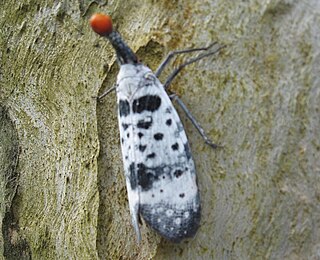
Pyrops clavatus is a species of true bug in the family Fulgoridae, in the genus Pyrops which are sometimes called "lanternflies". This species is found in parts of northern and northeastern India, Myanmar, northern Thailand, southern China and northern Vietnam. The tip of the elongated head capsule is spheroidal, shiny and chestnut in colour while the remainder of the process is black with fine white spotting. The forewing has a variable patterning of black, grey and white. The hindwing is purplish white with the apical half black. Specimens have been obtained along the Himalayas west to Mussoorie but more often in Assam, Sikkim, Shillong and the Khasi Hills.
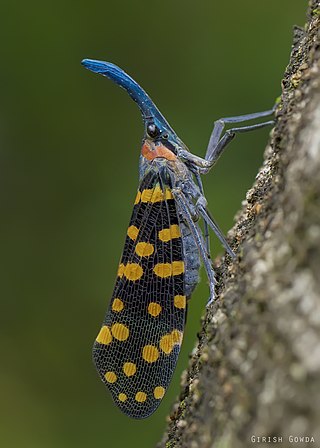
Pyrops delessertii is a species of true bug in the family Fulgoridae, in the genus Pyrops which are sometimes called "lanternflies". This species is found in the Nilgiris and Western Ghats of southern India. The head and "snout" or cephalic process is greenish. The thorax has a reddish colour and there are three spots on the mesonotum.
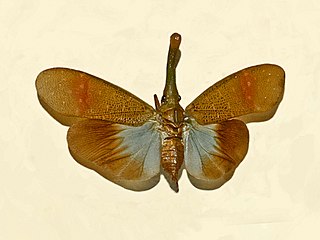
Pyrops pythicus is a species of true bug in the family Fulgoridae, in the genus Pyrops which are sometimes called lanternflies.
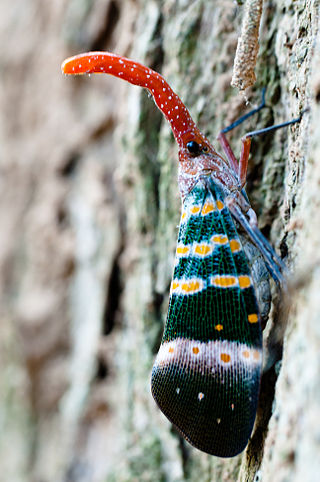
Pyrops karenius, also known as the Red-nosed Lanternfly, is a species of planthopper belonging to a group commonly referred to as lantern-flies. This species is found in Burma, Thailand and the Karen Hills of India. The head, its protrusion and the thorax are reddish brown. The cephalic process is slightly recurved and its tip is flattened.

Pyrops watanabei is a species of planthopper endemic to Taiwan. Pyrops atroalbus was formerly considered a subspecies; its status as a species was reinstated in 2017. P. watanabei was first described by Shōnen Matsumura in 1913 as Fulgora watanabei.

Pyrops coelestinus, previously known as Laternaria coelestina, is a species of planthopper belonging to a genus referred-to as lantern-bugs, sometimes known as the blue lantern bug.
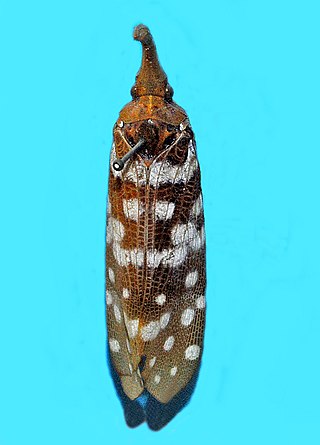
Pyrops maculatus is a species of planthopper belonging to the family Fulgoridae. A population is found in Sri Lanka while another is known from southwestern India.

Lycorma imperialis is a planthopper indigenous to parts of China and Indo-Malaysia. L. imperialis was originally discovered in 1846 by Adam White and has one recognized non-nominate subspecies, L. i. punicea. L. imperialis has undergone a number of reclassifications since its discovery and is one of four species in the genus Lycorma. L. imperialis follows a hemimetabolous life cycle and will undergo a series of nymphal stages (instars) before maturing to an adult.
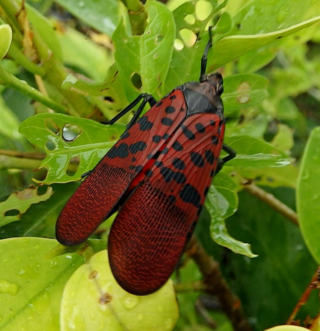
Lycorma meliae is a planthopper species endemic to Taiwan, with multiple, dramatically different color morphs depending on the life stage. The species was described by Masayo Kato in Taiwan in 1929, and is the only member of its genus confirmed to be native to the island. In 1929, a specimen of L. meliae was originally described as a separate species, L. olivacea, also by Kato. These two taxon names were declared synonymous in 2023. L. meliae undergoes four instar stages before achieving adulthood and specimen generally only survive till the winter.
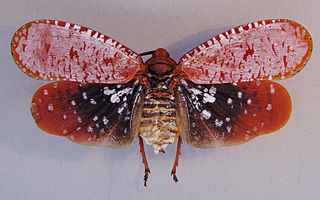
Aphaena submaculata is a species of planthoppers in the sub-family Aphaeninae of Fulgoridae. Various subspecies are distributed throughout the Indo-China region. The species was first observed by Frederick William Hope in 1840 and was formally described by James Duncan in 1843. Since then, it has undergone multiple reclassifications and now has 3 recognized subspecies which differ by color and/or length. The species feeds on tree sap via specialized mouthparts and follows a hemimetabolous life cycle.

Pyrops lathburii is a species of lanternfly found in North India, Northern Thailand, South China, Laos, and Vietnam.
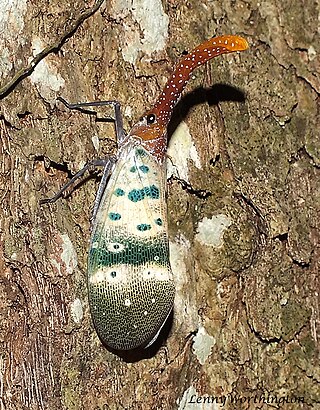
Pyrops ducalis is a species from the Fulgoridae family of lanternflies.

Pyrops viridirostris is a species of lanternfly of the family Fulgoridae found in NE India and Indochina.

Pyrops sultana is a species of lanternfly found on the island of Borneo.
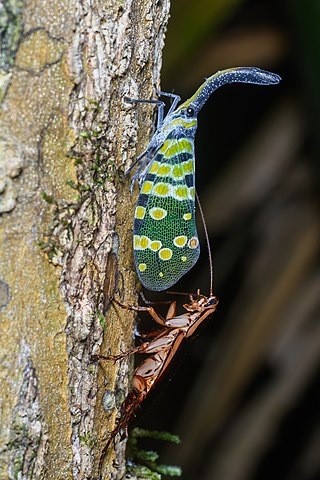
Pyrops connectens is a species of planthoppers from the Fulgoridae family.


















